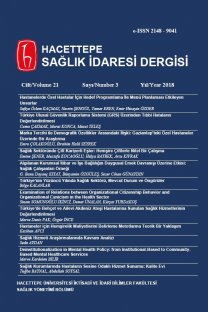Hekimler ile hemşirelerin örgütlerinin cazibe kaynaklarına ilişkin görüşleri
Yönetim biliminin önemli olgularından birisi, işgörenin örgüt hakkındaki çeşitli görüşlerinin sürekli olarak öğrenilmesi ve örgütün bunlardan kendisi için yararlı geri bildirimler üretmesidir. Örgüt cazibesi, işin ve çalışılan örgütün değişik özelliklerinin, işgörenin örgütte çalışmaya devam etme ya da örgütten ayrılma isteği üzerindeki etkilerinin belirlenmesidir. Sağlık kurumlarında örgütsel cazibe hakkında bilgi sahibi olunmasının, işgörenin yönetici tarafından anlaşılabilmesinde, izlenmesinde ve değerlendirilmesinde önemli ipuçları sağlayacağı düşünülmektedir. Hastanelerde çalışan hekimler ile hemşirelerin örgütlerinin cazibe kaynaklarına ilişkin görüşlerinin belirlenmesi amacıyla yapılan betimsel nitelikteki bu araştırma, Antalya il merkezinde çeşitli hastanelerde toplam 397 hekim ve hemşire üzerinde gerçekleştirilmiştir. Veriler yüz yüze görüşme tekniği kullanılarak toplanmıştır. Veri toplamada Porter, Crampon ve Smith tarafından geliştirilmiş ve Erigüç-Kaygın tarafından Türkçe'ye uyarlanmış olan "Örgütün Cazibe Kaynakları Ölçeği" kullanılmıştır. Hekim ve hemşirelerin %24.4'ü Sosyal Sigortalar Kurumu Hastanesi'nde, %35.8'i Devlet Hastanesi'nde ve %39.8'i Üniversite Hastanesi'nde çalışmaktadır. Devlet Hastanesi ile Üniversite Hastanesi 'nde çalışan hekimlerin örgütlerinin cazibe kaynaklarına ilişkin algıları, hemşirelerden daha olumsuzdur. Sosyal Sigortalar Kurumu Hastanesi'nde ise bu durumun tersine kadın hekimlerin örgütlerin cazibe kaynaklarına ilişkin olumlu değerlendirmeleri, erkek hekimlerden daha yüksektir. Hekimlerin örgütün cazibesine ilişkin algıları, unvana göre değişmemektedir. Ön lisans mezunu hemşirelerin örgütün cazibesine ilişkin algıları, sağlık meslek lisesi ile hemşirelik yüksek okulu mezunlarına göre daha yüksektir. Meslek ve hastane faktörleri de örgütsel cazibeye ilişkin algılar üzerinde etkilidir. Kıdem faktörünün örgütsel cazibeye ilişkin algılar üzerinde anlamlı etkisi bulunmamıştır. Hastane yöneticilerinin, çalışanların örgütlerini cazip olarak algılamalarına dönük yaklaşımlar içerisinde olmalarının yararlı olacağı düşünülmektedir.
Opinions of medical doctors and nurses about their organizational attachment sources
One of the most important facts of the organizational management is the continuous awareness of the personnel's different views on the organization and the usage of these opinions as a feedback for the organization itself. The aim of the organizational attachment is to determine the effect of various qualities of the work and the organization on the personnel's intention for carrying on with the work or leaving it. It is thought that in health organization getting the right knowledge about organization attachment will provide some important clues for the manager to get to know, observe and evaluate the personnel better. This descriptive study aiming to determine the attachment sources of the organizations of the medical doctors and nurses working in the hospital was performed in different hospitals located in Antalya and 397 medical doctors and nurses participated to the research. The findings were recorded by using face-to-face interview techniques. "The Scale for Attachment Sources of the Organization" that was established by Porter Crampon and Smith and adapted to Turkish by Eriguc Kaygın was used in the research. 24.4 % of the participating nurses and medical doctors have been working on Hospital of Social Security Organization, 35.8 % in State Hospital and 39.8 % in Medical Faculty Hospital in Antalya. Though the opinions of the doctors working in State Hospital and Medical Faculty Hospital relating to the attachment sources of the organization were more positive than of the nurses, the situation in Social Security Hospital is in opposite of that. The positive evaluation rate of the female medical doctors regarding attachment sources are higher than that of the male medical doctors. The perceptions of the attachment of the organization did not differ in accordance with the title of the medical doctors. In contrary to this, the perceptions of the nurses that graduated from the undergraduate departments were higher than those graduated from the nursing schools and vocational health schools. The factors of the profession and hospital also play an important role on the perception of the organizational attachment. However, seniority did not have a remarkable effect on the perceptions of organizational attachment. It is thought that hospital managers should make their organizations attachable.
___
- 1. Baysal A. C. (1985) Sosyal ve Örgütsel Psikolojide Tutumlar. İstanbul.
- 2. Büyüköztürk Ş. (2001) Deneysel Desenler. Öntest - Sontest Kontrol Grubu Desen ve Veri Analizi. Pegem Yayıncılık, Ankara.
- 3. Dubin R., Champoux J. E. and Porter L. W. (1975) Central Life Interests and Organizational Commitment of Blue-Collar and Clerical Workers. Administrative Science Quarterly 20: 411-421.
- 4. Erdoğan İ. (1997) İşletmelerde Davranış. Dönence Basım ve Yayın Hizmetleri, İstanbul.
- 5. Erigüç K. G. (1994). Hastanelerde Personelin İşle İlgili Tutumları Personel Devri: Ankara İli Örneği. Hacettepe Üniversitesi Sağlık Bilimleri Enstitüsü Yayınlanmamış Doktora Tezi. Ankara.
- 6. Erigüç-Kaygın G. ve Kavuncubaş Ş. (1996) Hemşirelerde İşten Ayrılma Eğilimine Nedensellik Yaklaşımı. Hacettepe Üniversitesi Hemşirelik Yüksekokulu Dergisi 3(2):32- 42.
- 7. Gürbüz Y., Karavuş M. ve Akdaş A. (2000) Birinci Basamak Sağlık Hizmetlerinde Çalışan Sağlık Personelinin İş Tatmini Düzeyleri. 3. Ulusal Sağlık ve Hastane Yönetimi Sempozyumu Bildiriler Kitabı. Ankara Üniversitesi Sağlık Eğitim Fakültesi. 28-29 Eylül, Ankara.
- 8. Mowday R. T., Porter L. W. and Dubin R. (1974) Unit Performance, Situational Factors and Employee Attitudes in Spatially Sperated Work Units. Organizational Behavior and Human Performance 12:231-248
- 9. Prohit A. and Stewart J. (1980) An Index of Job Satisfaction Among Pharmacist Part One: Facet-Free. Pharmacy Management 43:137-152.
- 10. Sencer M. ve Irmak Y. (1984) Toplum Bilimlerinde Yöntem. 2. Basım, Onur Basımevi, İstanbul.
- 11. Steers R. M. (1977) Antecedent and Outcomes of Organizational Commitment. Administratitive Science Quarterly 22: 46-56.
- 12. Stewart J. E. and Stewen S. N. (1987) Work Expectations and Organizational Attachment of Hospital Pharmacists. American Journal of Hospital Pharmacy 44:1105-1110.
- 13. Tsui A. S., Egan T. D. and O'reilly C. A. (1992) Being Different: Relational Demography and Organizational Attachment. Administrative Science Quarterly 37 :549-579.
- 14. Wallace J. E. (1995) Organizational and Professional Commitment in Professional and Nonprofessional Organizationans. Administrative Science Quarterly 40(1-4): 228.
- Yayın Aralığı: Yılda 4 Sayı
- Başlangıç: 2015
- Yayıncı: Hacettepe Üniversitesi İktisadi ve İdari Bilimler Fakültesi
Sayıdaki Diğer Makaleler
Hastanelerde sağlık personelini motive eden faktörlere ilişkin bir alan çalışması
Dilaver TENGİLİMOĞLU, Sevil AYKANAT
Üniversite hastanelerinda çalışan yönetici ve klinik sekreterlerinin iş doyumu
Aylanur ATAKLI, Elif DİKMETAŞ, Songül ALTINIŞIK
Hekimler ile hemşirelerin örgütlerinin cazibe kaynaklarına ilişkin görüşleri
Mukaddes ÖRS, Afsun Ezel ESATOĞLU, Ruhi Selçuk TABAK, Ahmet Münir ACUNER
